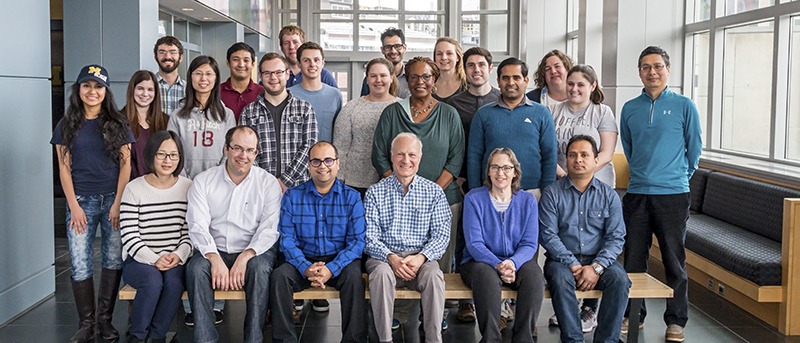As a dynamic interdisciplinary team of scientists, the Sherman laboratory studies the biosynthesis of natural products from terrestrial and marine microorganisms that include Cyanobacteria, Actinomycetes, and Myxobacteria. We continue to be inspired by natural products, and as a large proportion of FDA approved drugs has been based on natural products from both terrestrial and marine microbes, we seek to better understand their origins. Using a diverse set of tools that include molecular biology, genetics, biochemistry, structural biology, and bioorganic chemistry, we are uniquely poised to study the unique chemistry accomplished by Nature’s catalysts: enzymes. Leveraging our interdisciplinary skills, we explore and characterize these chemical catalysts evolved by Nature using fundamental principles of combinatorial biosynthesis. We actively seek to harness the tremendous capabilities of microoganisms to produce novel bioactive compounds as potential therapeutics to combat antibiotic resistance, infectious disease, and cancer through in vitro and in vivo engineering of natural product biosynthetic pathways.
Identifying new natural products
Natural product isolation and structural elucidation are cornerstones of the research in the Sherman laboratory. Due to the proven success of natural products as drugs, we strive to continually discover new natural products that highlight novel chemistry and enzymology. Taking advantage of creative laboratory culturing methods and relying on a solid structural elucidation foundation, our team of natural product chemists isolates numerous exciting compounds with a host of bioactivities, including anticancer, antibiotic, and antiparasitics. In addition, our team participates in extensive collaborations to establish bioactivity against a range of clinically relevant pathogens.
Investigating multimodular polyketide synthases
The natural products we isolate are often polyketides, an abundant class of secondary metabolites produced by a wide variety of organisms. This class of compounds constitutes an enormous source of complex bioactives that include commercially relevant compounds that include additives, pigments, veterinary growth promotants, and nutraceuticals. Manipulation of secondary biosynthetic pathways, such as the erythromycin polyketide synthase (PKS) gene cluster, has successfully led to the generation of libraries of unnatural compounds, but substantial work remains to better understand the different classes of PKSs. Therefore, PKS re-engineering promises to generate pathways for accessing new sources of valuable biologically active small molecules with pharmaceutical and/or commercial purposes. To this end, a more in-depth understanding of the multiple proteins involved and how they fundamentally interact is crucial. Therefore, we utilize principles of combinatorial biosynthesis, molecular genetics, and traditional molecular biology to gain a foothold towards exploiting these enzymes and pathways for the production of novel bioactives.
Substrate engineering for P450 biocatalysis
In addition to substantial efforts towards PKS biosynthetic pathway elucidation and engineering, our laboratory is also focused on the origins of structural diversity in natural product biosynthesis through the exploration of tailoring enzymes including cytochrome P450 monooxygenases (P450s), prenyltransferases, methyltransferases, and flavomonooxygenases. Enzymes provide exquisite regio- and stereoselectivity that remains unmatched through synthetic means. Therefore, we seek to continue to develop strategies of exploiting this high level of selectivity through fundamentally understanding these proteins through structural biology, mutagenesis studies, and biochemical and kinetic characterizations. P450s in particular are an impressive class of enzymes offering a promising source of biocatalysts given their capacity to perform regio- and stereoselective oxidations in late-stage biosynthetic tailoring.
Interrogating biosynthesis of bicyclo[2.2.2]diazaoctanes of fungal origin
Although bacterial sources, such as Streptomyces and other Actinomyces, have long provided an enormous source of intriguing bioactives, our laboratory seeks to develop research tools and methods of understanding the production of metabolites in eukaryotic hosts, such as fungi. These unique organisms are able to produce a suite of natural products whose antipodal counterparts can often be found in phylogenetically unrelated organisms. Using extensive bioinformatics tools and established synthetic collaborations, we are able to derive novel pathways through feeding studies, molecular biology, and biochemical analysis. In this way, our laboratory seeks to expand our understanding of eukaryotic metabolites through biological pathway interrogation and evolutionary biology.
Using synthetic chemistry to explore chemoenzymatic synthesis
The Sherman laboratory continues to delve deeper into the biology and biochemistry of microorganisms producing intriguing bioactives by leveraging the expertise of synthetic chemistry. Our team of experienced synthetic chemists are intimately involved in studying enzyme function, structure, and flexibility from entire PKS modules down to single domains. They provide enzyme substrates, enzymatic intermediates, and complex natural product analogs not easily accessible through traditional synthetic schemes. These chemoenzymatic methods are efficient and divergent to produce a large number of high-value bioactive analogs. In addition, our synthetic chemists strive to support extensive biochemistry and structural biology work through the design of substrate mimics and synthesis of authentic standards.



